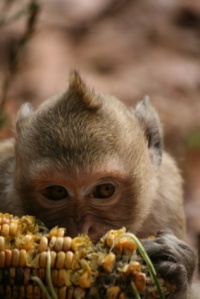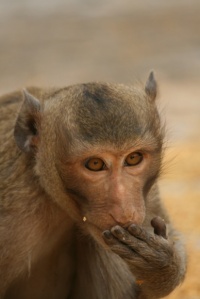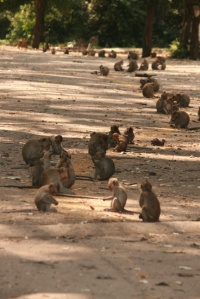Contributed by Elliott Capp
Here is a brief update about what the long-tailed macaque (Macaca fascicularis) research team in Phana (north-east Thailand) have been up to over the first month of their research project:
After being slightly overwhelmed upon our arrival by the sheer number of monkeys that were resident in the small forest, we decided the first course of action was to determine just how many there were and carry out a population census. But how do you get an accurate representation of a species that spends a lot of its time in the trees? – We needed a plan! After a few days of general observations of the monkeys we noticed that when they were provisioned with rice by the local council twice a week, they all sat neatly in a line whilst feeding – this was to provide us a large proportion of the population.
Figure 1: Macaque eating provisioned corn
We carried out our population censuses at 7am, just after the monkeys had got up to try and ensure the least amount of disturbance as possible from members of the public provisioning the monkeys, and so that they would be at their hungriest and most tempted by the rice. We informed the council how we would like the rice to be distributed to try and encourage as many long-tailed macaques to the ground. We carried out four counts, with 6 people counting in different areas of the forest to prevent overlap, to get a more reliable representation, and we were once again taken slightly aback when we tallied up the numbers and there were over 700 monkeys, with a massive female sex bias, present in this small woodland (48 acres).
Figure 2: Juvenile Long-Tailed Macaque
When we were not counting the monkeys, we were mapping the forest and carrying out phase one habitat surveys. The forest map allowed us to plot where the monkeys were spending their time, and through random sampling we were able to gain a better understanding of the pattern of movements of the monkeys through the forest throughout the day.
Figure 3: Counting 700 monkeys up trees would prove difficult
To map the forest we used a combination of GPS, measuring tapes, and Google maps. The phase 1 habitat survey was carried out using adapted Phase 1 Habitat Survey Procedure (JNCC, 2010). We gridded the forest into 25 equal areas and then used this to gain a greater understanding of where they were. To find out where the monkeys were during the day, over a period of 2 weeks, we used a random number generator to select a part of the forest, we then spent ten minutes in these areas establishing if long-tailed macaques were present, and if so, how many, and of what age and sex they were.
Figure 4: Feeding time at the forest
So what’s the next step? – Over the next few weeks we want to gain a greater comprehension of what the monkeys spend their time doing. To do this we are going to create an ethogram of the behaviours that they carry out, through ad libitum sampling, and then perform continuous focal sampling on them to see which behaviours they are using, in order to be able to compare macaques of different sex and age.
Figure 5: Monkeys patiently waiting to be counted
As a side project I am trying to carry out a butterfly biodiversity study, so I will let you know the trials and tribulations that are associated with the task!fers
NB This post refers to research carried out in Phana January – April 2012.





